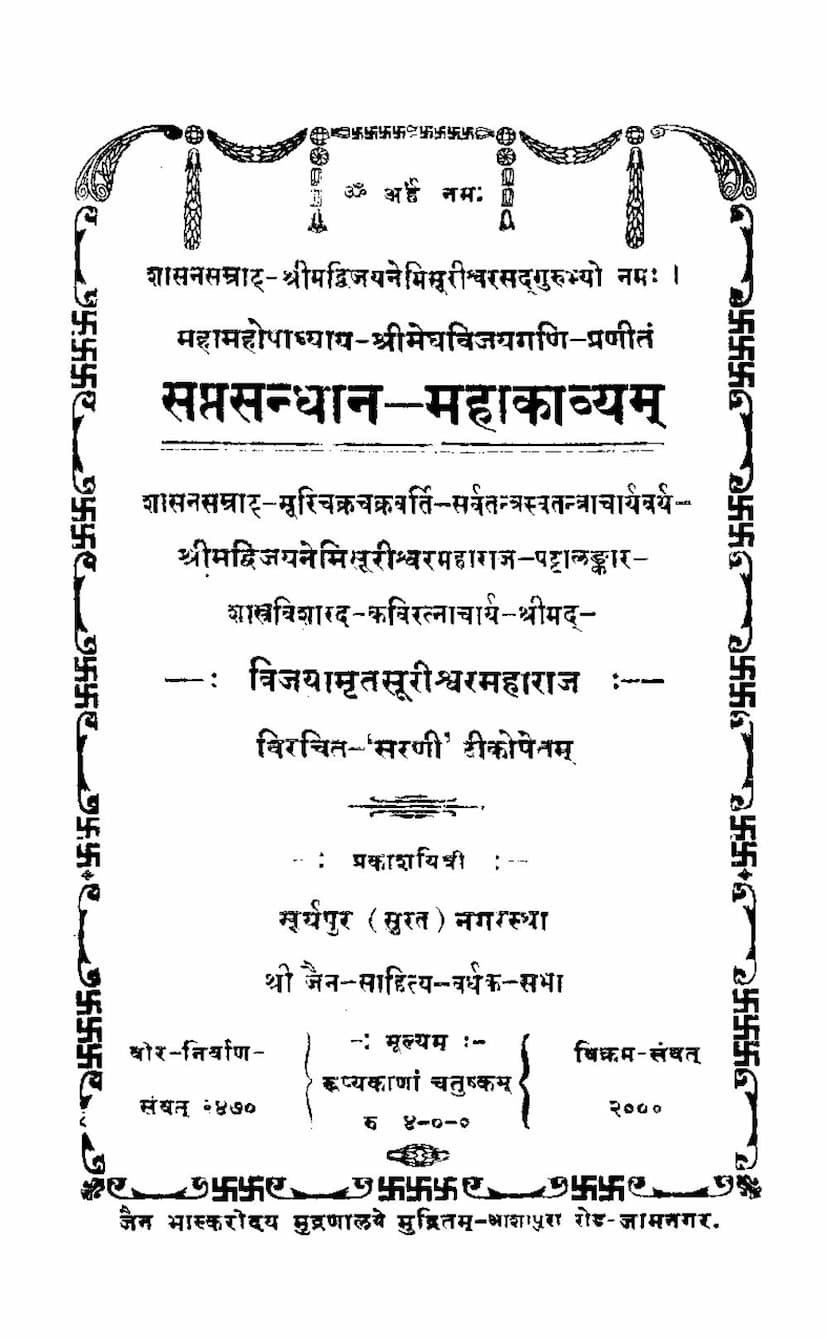Saptasandhan Mahakavya
Added to library: September 2, 2025

Summary
This document is an introduction and partial summary of the Jain text "Saptasandhan Mahakavya" by Acharya Meghvijay and Amrutchandracharya, published by Shri Jain Sahitya Vardhak Sabha.
Here's a breakdown of the key information:
Title: Saptasandhan Mahakavya (meaning "Great Epic of Seven Compilations" or "Seven Connections"). Authors: Acharya Meghvijay (primary author of the main kavya) and Amrutchandracharya (author of the commentary 'Sarani'). Publisher: Shri Jain Sahitya Vardhak Sabha, Maryadpur (Surat). Catalog Link: jainqq.org/explore/008453/1 Date: Vikram Samvat 1995 (2000 according to the text's numbering, which seems to be a separate publication year, possibly for the edition with the commentary).
Key Features of the Saptasandhan Mahakavya:
The text highlights the uniqueness and exceptional value of this Mahakavya through several points:
- Sevenfold Meaning (Saptarthak/Saptasandhan): Unlike other poems where a verse might have one or two meanings, each verse in this Mahakavya is designed to convey the life and teachings of seven great individuals simultaneously.
- Supreme Narratives: The epic narrates the lives of the most exalted beings: Lord Rishabhdev, Lord Shantinath, Lord Neminath, Lord Parshvanath, Lord Mahavir Swami, along with Lord Rama and Lord Krishna Vasudev, who are considered supreme beings in their respective traditions and are accepted as exemplary figures in Jainism as well.
- Limiting and Elevated Rasa: Other poems might focus on erotic (Shringar) or ghastly (Bibhatsa) sentiments, which are often repulsive to refined sensibilities. This Mahakavya, while incorporating limited amounts of such rasas, primarily emphasizes the serene (Shanta) rasa, leading to an ultimate conclusion in Shanta rasa, making it worthy of respect and study for all virtuous individuals.
- Concise yet Comprehensive: It avoids lengthy descriptions of irrelevant topics, a common issue in other extensive poems. Instead, it covers the essential aspects of the lives of the seven great personalities within its 442 muktas (verses) in an engaging style.
- Excellence in Literary Elements: The work is rich in both Shabdalamkaras (word ornaments) and Arthalamkaras (meaning ornaments). It incorporates various other features essential for a Mahakavya, such as different meters (chhandas), descriptions of seasons (ritu varnan), and more. The first four verses are mangalacharan, followed by eleven verses on the praise and criticism of good and bad people, filled with clever imaginations and shlesh-alamkara. It then details the specific regions and cities where the seven protagonists were born, describes their parents, queens, and the circumstances of their birth.
- Author's Legacy and Revival: The original creator of this concept was the great scholar Shri Hemchandrasuriji Maharaj. However, due to the ravages of time, his work was lost. It was later revived and completed by the highly accomplished scholar Upadhyay Meghvijay Ganini. The text emphasizes Upadhyay Meghvijay's extraordinary ability in completing verses (padaparti), a skill said to be unparalleled. His other works, like completing Naishadhiya Kavya and Meghaduta, are mentioned.
- The Commentary 'Sarani': The original commentary by the author is no longer available. However, Acharya Shri Vijayamrutsurishwarji Maharaj (decorated with the title of Shattantra Swatantramurichakra Chakravarthi) spent years compiling a commentary named 'Sarani' for this Mahakavya, making it accessible for study.
Overall Purpose of the Mahakavya:
The Saptasandhan Mahakavya aims to provide an unparalleled experience of profound bliss through the study of the lives of these seven supreme beings. It enriches the knowledge of scholars and adorns their libraries. The text encourages readers to study and teach this unique kavya for their spiritual and intellectual welfare.
The document also includes a table of contents (प्रधानविषयानुक्रमणिका) detailing the content of each of the nine sections (Sargas) of the Mahakavya, further elaborating on the specific topics and subjects covered within each. The introduction emphasizes that this work is a gem in Sanskrit literature, offering profound insights and spiritual elevation.